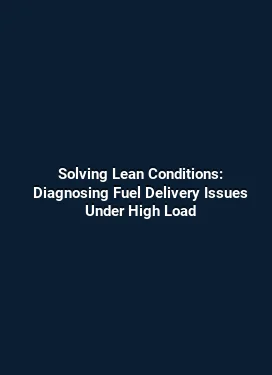How to Install Individual Throttle Bodies on BMW M3 S54 Engine
The BMW M3 with the S54 powerplant is renowned for its response and high-revving character. Upgrading to individual throttle bodies (ITBs) can unlock more precise air delivery, improved throttle response, and potential power gains when paired with a proper intake and fueling strategy. This comprehensive guide focuses on practical, real-world steps, materials, common pitfalls, and tuning considerations that help enthusiasts achieve a reliable, performance-oriented ITB installation on the S54 engine.
Prerequisites and Conceptual Overview

Before diving into hardware specifics, it is essential to understand what ITBs do and how they fit into the S54’s intake and fueling ecosystem. Individual throttle bodies replace the single throttle plate that regulates air for all cylinders with a dedicated, independently controlled throttle body for each bank or cylinder, depending on the kit. This configuration tends to improve airflow metering resolution, throttle response, and intake tract tuning, particularly at mid-to-high RPM ranges where the engine breathes aggressively.
When considering ITB installation, several interdependent systems come into play: intake runners, throttle bodies, fuel delivery (injectors, rails, pressure), engine management, sensors, and intake manifold geometry. The result is a more complex but potentially more capable intake system that requires careful planning, precise metering, and robust calibration. This section outlines the core considerations and sets the stage for the detailed steps that follow.
Compatibility and kit selection

Not all ITB kits are created equal on the S54 platform. Key compatibility factors include: fitment with the stock engine bay geometry, compatibility with OEM or aftermarket intake manifolds, and whether the kit offers a matched fuel rail and injector configuration. It is common to pair ITBs with a purpose-built intake plenum that re-tunes runners for balanced cylinder charging, as well as a compatible fuel delivery solution that ensures consistent injector spray patterns and adequate fuel pressure under load.
When evaluating a kit, review the following: adapter plates for throttle bodies, mounting hardware quality, gasket integrity, throttle linkages or electronic throttle control compatibility, and the availability of a tuned ECU calibration or base maps. The S54’s valve angles and head architecture demand careful attention to port matching and plenum design to avoid air leaks and unwanted turbulence that can degrade idle stability and throttle response.
Preparation, Tools, and Workspace
Effective ITB installation starts long before the first bolt is removed. A clean, well-organized workspace minimizes the risk of contamination and error. Gather essential tools such as a full metric socket and wrench set, torque wrench, thread sealant, gasket sealer, calibrated fuel pressure gauge, fuel line removal tools, and appropriate cutting and routing aids for the intake plumbing.
Prepare the engine bay by removing the stock intake system, ensuring the throttle body area is free of debris, and inspecting the intake ports and cylinder head surfaces for imperfections. It is prudent to check for vacuum lines, PCV plumbing, and sensor harnesses that may need re-routing or lengthening to accommodate the ITB layout. A detailed plan that identifies routing paths for air, fuel, and sensors reduces surprises during reassembly.
Tools and accessories to consider
Besides standard hand tools, specific items can simplify the installation: a precision injector removal tool, high-quality fuel hose clamps with appropriate heat resistance, a torque adapter for precise fastener application, and an inline fuel pressure gauge for on-car verification. It is also beneficial to have data-logging equipment or a software interface that can capture air mass, fuel trims, and RPM during initial startup and calibration runs. The S54's engine management requires reliable sensor input to avoid misfires and to maintain stable idle during drivability checks.
Mechanical Installation Steps
The physical installation is a staged process that emphasizes cleanliness, alignment, and secure sealing. Begin with removing the stock intake apparatus and preparing the cylinder head ports for ITB compatibility. Each ITB needs a precise seal to prevent air leaks, which can otherwise manifest as rough idle, misfires, or lean conditions under acceleration.
Step-by-step guidance follows a logical order: mounting the ITB assemblies, connecting the throttle linkages or electronic throttle control, fitting the intake plenum or runner assemblies, and ensuring fuel rail alignment with injectors. A critical part of this phase is port matching between the head and ITB runners. Integrate a gasket set that matches the S54’s port geometry, and verify that all mating surfaces are clean and flat before applying sealant or gaskets.
Mounting and alignment considerations
Alignment is paramount when using ITBs. Misalignment can introduce air leakage paths, throttle body binding, or uneven intake runner lengths that create unfavorable air dynamics. Start with loosely fitting mounting hardware to verify alignment visually. Then gradually tighten fasteners to the specified torque, ensuring even clamping pressure across the gasket interface. When dealing with multi-throttle assemblies, ensure the throttle shafts are synchronized to avoid cross-coupling effects that can cause uneven fuel delivery across cylinders.
The S54 engine benefits from an intake plenum designed to homogenize airflow from ITBs into the intake runners. If the kit provides a dedicated plenum, install it in a way that preserves short, direct paths for air to each cylinder while avoiding sharp bends that induce turbulence. Proper routing of vacuum lines and sensor leads helps maintain stable engine operation from idle to redline.
Fuel delivery integration
ITBs typically require a matching fuel rail and high-quality injectors capable of maintaining precise flow characteristics. Ensure the injectors are compatible with the ITB’s spray pattern and the ECU’s control strategy. Secure the fuel rail with appropriate clamps and verify that injector seals sit flush against the rail bosses and the intake ports. Fuel lines should run away from hot surfaces and be protected from vibration. Use anti-siphon and check valves if recommended by the kit manufacturer to prevent fuel siphoning during startup or after shutdown.
Pressure consistency is crucial. An elevated fuel pressure can aid atomization at higher RPMs, but this must be paired with ECU calibration adjustments to avoid rich conditions. Conversely, low pressure can cause lean misfires and poor cold-start behavior. Plan for a fuel pressure regulator suitable for the ITB configuration and ensure it maintains stable pressure across the engine’s operating envelope.
Electrical, Sensors, and Tuning Foundations
Installing ITBs changes the air metering dynamics and requires careful re-tuning of the engine management system. Sensor compatibility and proper mapping for air mass, throttle position, and knock sensing become more prominent as the engine breathes through individual throttles. If the chosen kit includes an ECU remap or standalone management, follow the manufacturer’s guidelines for wiring, sensor scaling, and feed-forward maps. An accurate ignition timing strategy is essential to prevent detonation, especially at high load and high RPM conditions that ITBs often promote.
Aside from the ECU, ensure that the MAF or MAP sensor arrangement works with the ITB configuration. Some setups relocate or replace these sensors, while others retain stock placements with revised calibration. Maintaining robust wiring harness routing and securing connectors against heat and vibration reduces intermittent sensor faults. When integrating with the stock pedal or a modern drive-by-wire system, verify that pedal mapping and throttle response harmonize with the new throttle bodies to preserve smooth throttle transitions.
Calibration and drive-by-wire compatibility
Calibration is the bridge between hardware and performance. Start with baseline idle and open-throttle mappings to establish a stable starting point. Incrementally test throttle response and monitor for any hesitations or lean/rich transients. If the kit requires a separate intake air temperature sensor or manifold pressure sensor, ensure those readings are accurate, as they influence fuel and ignition strategies. For drive-by-wire setups, confirm that the throttle-by-wire controller communicates correctly with the ECU, and that throttle plate synchronization is executed precisely to avoid mechanical lag or inconsistent transitions during gear changes or rapid throttle inputs.
Utilize data logging to capture air-fuel ratio, fuel trims, intake manifold pressure, and throttle position during various driving scenarios. This data informs adjustments to injector pulse widths, ignition timing, and part-throttle behavior. A well-tuned ITB system should offer crisp throttle response across RPM bands without sacrificing idle stability or drivability in traffic conditions.
Testing, Break-In, and Maintenance
After installation and initial calibration, conduct a structured testing protocol to validate performance and reliability. Begin with idle stability checks, then progress to light cruising, followed by a controlled test at higher RPM in a closed environment. Monitor engine temperatures, fuel pressure, and sensor readings to identify any anomalies such as vacuum leaks, misfires, or erratic idle. A safe, methodical testing routine reduces the risk of damage during the learning phase of the ECU maps.
Break-in considerations for ITBs focus on ensuring stable lubrication of moving parts, verifying fuel atomization, and preventing carbon buildup from rich fueling events during tuning intervals. Regular maintenance should include inspection of gasket surfaces for leaks, verification of injector seals, and periodic checking of connector integrity. It is also advisable to inspect the air-fuel ratio sensor, if present, and replace it according to manufacturer guidelines to maintain accurate feedback for ongoing tuning.
Common pitfalls and how to avoid them
Air leaks at gasket interfaces are a frequent source of idle instability and lean conditions. Use proper gasket material compatible with the ITB design and ensure surfaces are clean and free of debris before assembly. Misalignment of throttle bodies or misrouted sensors can lead to inconsistent readings and drivability issues. Double-check throttle linkage tangency, ensure uniform throttle plate travel across all cylinders, and verify that the throttle blades close completely when the pedal is released to avoid drivetrain jerks or surging under deceleration.
Fuel delivery problems often stem from inadequate return paths or pressure instability. Keep fuel lines away from hot surfaces and ensure all clamps are secure. During initial startup, monitor fuel pressure to confirm it remains within the expected range. Inadequate cooling or ignition timing misalignment can lead to detonation, particularly at high RPM and boost-like conditions. A conservative approach to ignition timing during early calibration reduces the risk of engine damage while tuning gains are explored.
Real-World Scenarios and Practical Tips
Owners report that ITB upgrades on the S54 can yield tactile throttle response improvements, especially in the mid-to-high RPM range where stock intake manifolds can become a bottleneck. For those targeting track performance, ITBs paired with a purpose-built intake plenum and a tuned ECU can translate into more immediate throttle response, improved engine breathing, and a broader usable RPM range. The real value often lies in the combination of mechanical precision, fuel strategy, and disciplined calibration rather than isolated hardware changes.
In daily driving, ITBs should maintain smooth idle, stable cold starts, and consistent performance in varying environmental conditions. It is common to adjust the cam timing or switchover strategies for cold start enrichment and warm-up behavior; however, the core objective remains steady air metering, stable spray patterns from injectors, and reliable ignition timing throughout the engine’s operating envelope.
Documentation, Resources, and Team Coordination
Successful ITB installations benefit from clear documentation of every step, including torque values, gasket part numbers, and sensor wiring diagrams. Maintain an organized library of calibration maps, test results, and any revisions to wiring or sensor placements. Collaboration with experienced technicians or a knowledgeable community can help troubleshoot corner cases such as idle fluctuations or transient lean events under rapid throttle changes.
Finally, ensure compliance with local regulations and emissions requirements. Some ITB configurations may alter emissions characteristics or require specific certifications depending on regional rules. A thoughtful approach to installation, calibration, and documentation can help maintain reliability and legal conformity while delivering the intended performance gains.






